核心交换机HSR
- 格式:doc
- 大小:31.50 KB
- 文档页数:3
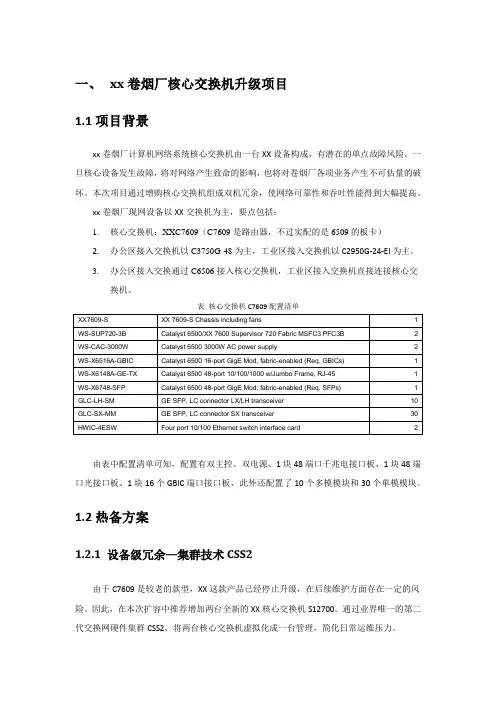
一、xx卷烟厂核心交换机升级项目1.1项目背景xx卷烟厂计算机网络系统核心交换机由一台XX设备构成,有潜在的单点故障风险。
一旦核心设备发生故障,将对网络产生致命的影响,也将对卷烟厂各项业务产生不可估量的破坏。
本次项目通过增购核心交换机组成双机冗余,使网络可靠性和吞吐性能得到大幅提高。
xx卷烟厂现网设备以XX交换机为主,要点包括:1.核心交换机:XXC7609(C7609是路由器,不过实配的是6509的板卡)2.办公区接入交换机以C3750G-48为主,工业区接入交换机以C2950G-24-EI为主。
3.办公区接入交换通过C6506接入核心交换机,工业区接入交换机直接连接核心交换机。
表核心交换机C7609配置清单由表中配置清单可知,配置有双主控、双电源、1块48端口千兆电接口板、1块48端口光接口板、1块16个GBIC端口接口板,此外还配置了10个多模模块和30个单模模块。
1.2热备方案1.2.1 设备级冗余—集群技术CSS2由于C7609是较老的款型,XX这款产品已经停止升级,在后续维护方面存在一定的风险。
因此,在本次扩容中推荐增加两台全新的XX核心交换机S12700。
通过业界唯一的第二代交换网硬件集群CSS2,将两台核心交换机虚拟化成一台管理,简化日常运维压力。
区别于传统的VRRP或HSRP(XX私有)等热备方案,虚拟化方案成为构建品质园区网络的首选,即将两台核心交换机逻辑地虚拟化成一个网元。
两台物理独立的设备在逻辑上是一个网元,相当于设备进行了端口扩容。
在管理上,只需要一个IP地址,便可对整个网元进行管理和配置。
CSS2(Cluster Switch System Generation2,第二代集群交换机系统)是在CSS的基础上推出的第二代硬件集群系统。
CSS2采用交换网硬件集群,支持集群主控1+N备份,集群系统的控制平面与转发平面分离,CSS2不占用业务槽位,具有低延时,大带宽,高可靠的特点。
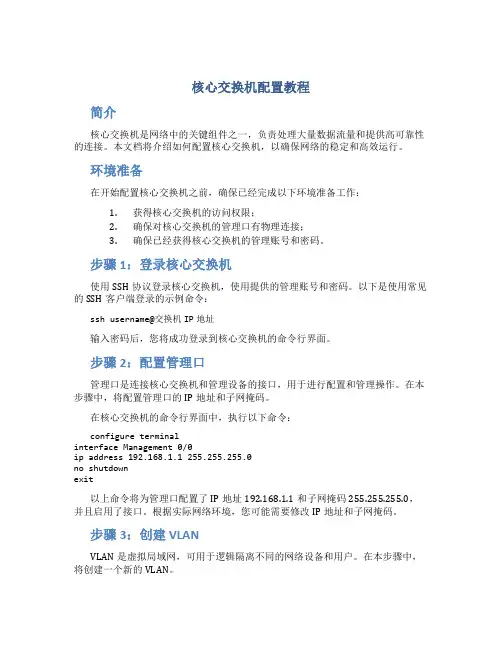
核心交换机配置教程简介核心交换机是网络中的关键组件之一,负责处理大量数据流量和提供高可靠性的连接。
本文档将介绍如何配置核心交换机,以确保网络的稳定和高效运行。
环境准备在开始配置核心交换机之前,确保已经完成以下环境准备工作:1.获得核心交换机的访问权限;2.确保对核心交换机的管理口有物理连接;3.确保已经获得核心交换机的管理账号和密码。
步骤1:登录核心交换机使用SSH协议登录核心交换机,使用提供的管理账号和密码。
以下是使用常见的SSH客户端登录的示例命令:ssh username@交换机IP地址输入密码后,您将成功登录到核心交换机的命令行界面。
步骤2:配置管理口管理口是连接核心交换机和管理设备的接口,用于进行配置和管理操作。
在本步骤中,将配置管理口的IP地址和子网掩码。
在核心交换机的命令行界面中,执行以下命令:configure terminalinterface Management 0/0ip address 192.168.1.1 255.255.255.0no shutdownexit以上命令将为管理口配置了IP地址192.168.1.1和子网掩码255.255.255.0,并且启用了接口。
根据实际网络环境,您可能需要修改IP地址和子网掩码。
步骤3:创建VLANVLAN是虚拟局域网,可用于逻辑隔离不同的网络设备和用户。
在本步骤中,将创建一个新的VLAN。
在核心交换机的命令行界面中,执行以下命令:configure terminalvlan 10name TestVLANexit以上命令创建了一个编号为10的VLAN,并将其命名为TestVLAN。
根据实际需求,您可以创建多个VLAN,并为每个VLAN指定不同的名称。
步骤4:配置Trunk口Trunk口用于连接不同交换机之间的VLAN信息传递。
在本步骤中,将配置一个Trunk口。
在核心交换机的命令行界面中,执行以下命令:configure terminalinterface GigabitEthernet 1/1switchport mode trunkswitchport trunk allowed vlan 10exit以上命令将接口GigabitEthernet 1/1配置为Trunk口,并允许通过这个Trunk 口传递VLAN 10的信息。
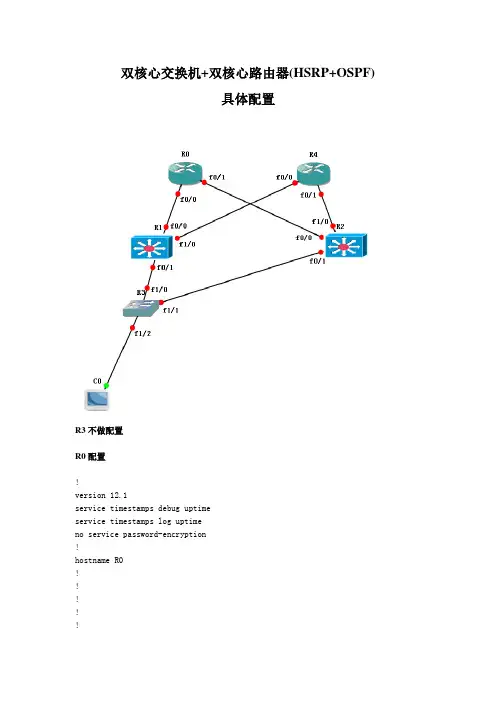
双核心交换机+双核心路由器(HSRP+OSPF)具体配置R3不做配置R0配置!version 12.1service timestamps debug uptimeservice timestamps log uptimeno service password-encryption!hostname R0!!!!!memory-size iomem 15ip subnet-zero!!!!interface FastEthernet0/0ip address 192.168.0.1 255.255.255.0 duplex autospeed auto!interface FastEthernet0/1ip address 172.16.0.1 255.255.0.0duplex autospeed auto!router ospf 1log-adjacency-changesnetwork 172.16.0.0 0.0.255.255 area 0 network 192.168.0.0 0.0.0.255 area 0 !ip classlessno ip http server!!line con 0transport input noneline aux 0line vty 0 4login!no scheduler allocateendR1配置!version 12.1service timestamps debug uptime service timestamps log uptimeno service password-encryptionhostname R1!!!!!!memory-size iomem 15ip subnet-zero!!!!interface FastEthernet0/0ip address 192.168.0.2 255.255.255.0 duplex autospeed auto!interface FastEthernet0/1ip address 10.0.0.1 255.0.0.0duplex autospeed autostandby 1 priority 150 preemptstandby 1 ip 10.0.0.3standby 1 track Fa0/0 51!interface FastEthernet1/0ip address 172.17.0.2 255.255.0.0ip ospf cost 2duplex autospeed auto!router ospf 1log-adjacency-changesnetwork 10.0.0.0 0.255.255.255 area 0 network 172.17.0.0 0.0.255.255 area 0 network 192.168.0.0 0.0.0.255 area 0 !ip classlessno ip http server!!line con 0transport input noneline aux 0line vty 0 4login!endR2配置!version 12.1service timestamps debug uptime service timestamps log uptimeno service password-encryption!hostname R2!!!!!!memory-size iomem 15ip subnet-zero!!!!interface FastEthernet0/0ip address 172.16.0.2 255.255.0.0duplex autospeed auto!interface FastEthernet0/1ip address 10.0.0.2 255.0.0.0duplex autospeed autostandby 1 preemptstandby 1 ip 10.0.0.3!interface FastEthernet1/0ip address 192.168.1.2 255.255.255.0ip ospf cost 2duplex autospeed auto!router ospf 1log-adjacency-changesnetwork 10.0.0.0 0.255.255.255 area 0 network 172.16.0.0 0.0.255.255 area 0 network 192.168.1.0 0.0.0.255 area 0 !ip classlessno ip http server!!line con 0transport input noneline aux 0line vty 0 4login!endR4配置!version 12.1service timestamps debug uptime service timestamps log uptimeno service password-encryption!hostname R4!!!!!!memory-size iomem 15ip subnet-zero!!!!interface FastEthernet0/0ip address 172.17.0.1 255.255.0.0ip ospf cost 2duplex autospeed auto!interface FastEthernet0/1ip address 192.168.1.1 255.255.255.0 ip ospf cost 2duplex autospeed auto!router ospf 1log-adjacency-changesnetwork 172.17.0.0 0.0.255.255 area 0 network 192.168.1.0 0.0.0.255 area 0 !ip classlessno ip http server!!line con 0transport input noneline aux 0line vty 0 4login!end。
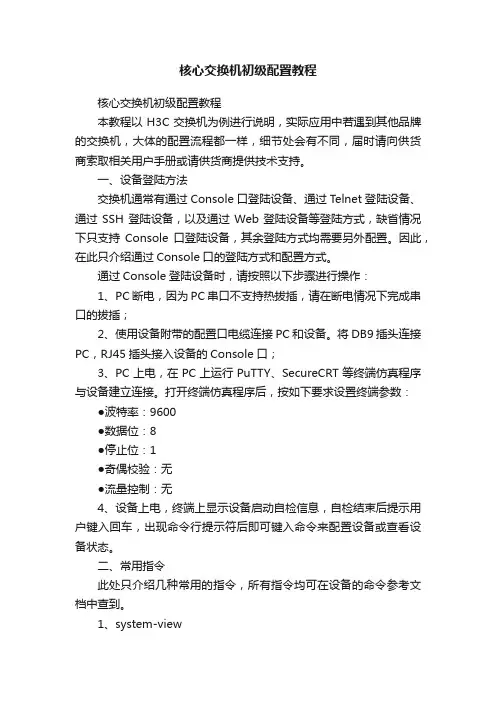
核心交换机初级配置教程核心交换机初级配置教程本教程以H3C交换机为例进行说明,实际应用中若遇到其他品牌的交换机,大体的配置流程都一样,细节处会有不同,届时请向供货商索取相关用户手册或请供货商提供技术支持。
一、设备登陆方法交换机通常有通过Console口登陆设备、通过Telnet登陆设备、通过SSH登陆设备,以及通过Web登陆设备等登陆方式,缺省情况下只支持Console口登陆设备,其余登陆方式均需要另外配置。
因此,在此只介绍通过Console口的登陆方式和配置方式。
通过Console登陆设备时,请按照以下步骤进行操作:1、PC断电,因为PC串口不支持热拔插,请在断电情况下完成串口的拔插;2、使用设备附带的配置口电缆连接PC和设备。
将DB9插头连接PC,RJ45插头接入设备的Console口;3、PC上电,在PC上运行PuTTY、SecureCRT等终端仿真程序与设备建立连接。
打开终端仿真程序后,按如下要求设置终端参数:●波特率:9600●数据位:8●停止位:1●奇偶校验:无●流量控制:无4、设备上电,终端上显示设备启动自检信息,自检结束后提示用户键入回车,出现命令行提示符后即可键入命令来配置设备或查看设备状态。
二、常用指令此处只介绍几种常用的指令,所有指令均可在设备的命令参考文档中查到。
1、system-view用来从用户视图进入系统视图2、display current-configuration查看设备当前配置信息3、vlanvlan vlan-id 命令用来创建VLAN,并进入VLAN 视图。
如果指定的VLAN 已存在,则直接进入该VLAN 的视图。
vlan vlan-id-list 命令用来批量创建VLAN,保留VLAN 除外。
vlan all 命令用来批量创建VLAN 1~4094。
undo vlan 命令用来删除VLAN。
该指令在系统视图下使用。
系统有一个缺省VLAN(VLAN1),用户不能删除该缺省VLAN。
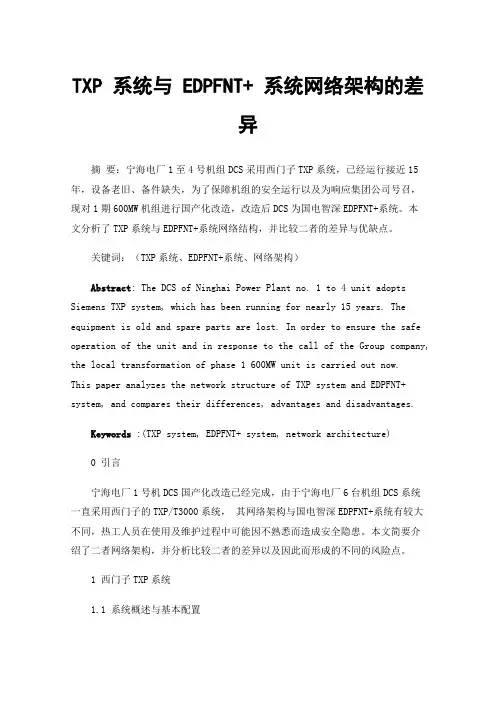
TXP 系统与 EDPFNT+ 系统网络架构的差异摘要:宁海电厂1至4号机组DCS采用西门子TXP系统,已经运行接近15年,设备老旧、备件缺失,为了保障机组的安全运行以及为响应集团公司号召,现对1期600MW机组进行国产化改造,改造后DCS为国电智深EDPFNT+系统。
本文分析了TXP系统与EDPFNT+系统网络结构,并比较二者的差异与优缺点。
关键词:(TXP系统、EDPFNT+系统、网络架构)Abstract: The DCS of Ninghai Power Plant no. 1 to 4 unit adopts Siemens TXP system, which has been running for nearly 15 years. The equipment is old and spare parts are lost. In order to ensure the safe operation of the unit and in response to the call of the Group company, the local transformation of phase 1 600MW unit is carried out now.This paper analyzes the network structure of TXP system and EDPFNT+ system, and compares their differences, advantages and disadvantages.Keywords :(TXP system, EDPFNT+ system, network architecture)0 引言宁海电厂1号机DCS国产化改造已经完成,由于宁海电厂6台机组DCS系统一直采用西门子的TXP/T3000系统,其网络架构与国电智深EDPFNT+系统有较大不同,热工人员在使用及维护过程中可能因不熟悉而造成安全隐患。
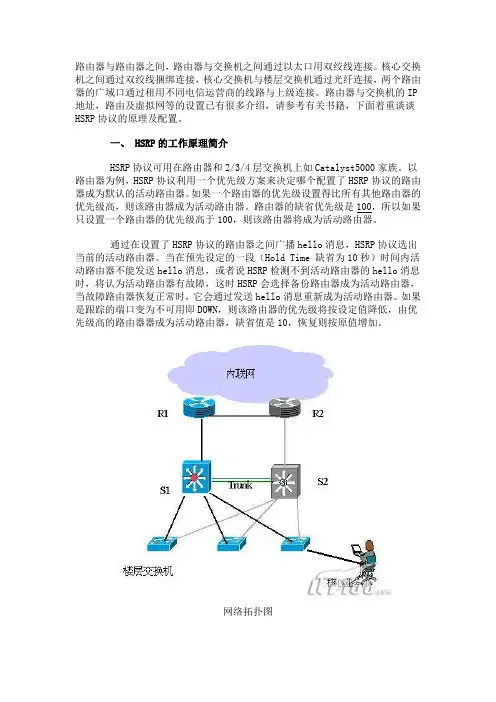
路由器与路由器之间,路由器与交换机之间通过以太口用双绞线连接。
核心交换机之间通过双绞线捆绑连接,核心交换机与楼层交换机通过光纤连接,两个路由器的广域口通过租用不同电信运营商的线路与上级连接。
路由器与交换机的IP 地址,路由及虚拟网等的设置已有很多介绍,请参考有关书籍,下面着重谈谈HSRP协议的原理及配置。
一、 HSRP的工作原理简介HSRP协议可用在路由器和2/3/4层交换机上如Catalyst5000家族。
以路由器为例,HSRP协议利用一个优先级方案来决定哪个配置了HSRP协议的路由器成为默认的活动路由器。
如果一个路由器的优先级设置得比所有其他路由器的优先级高,则该路由器成为活动路由器。
路由器的缺省优先级是100,所以如果只设置一个路由器的优先级高于100,则该路由器将成为活动路由器。
通过在设置了HSRP协议的路由器之间广播hello消息,HSRP协议选出当前的活动路由器。
当在预先设定的一段(Hold Time 缺省为10秒)时间内活动路由器不能发送hello消息,或者说HSRP检测不到活动路由器的hello消息时,将认为活动路由器有故障,这时HSRP会选择备份路由器成为活动路由器,当故障路由器恢复正常时,它会通过发送hello消息重新成为活动路由器。
如果是跟踪的端口变为不可用即DOWN,则该路由器的优先级将按设定值降低,由优先级高的路由器器成为活动路由器,缺省值是10,恢复则按原值增加。
网络拓扑图所有参与HSRP的路由器共享一个虚的IP地址,网络中的工作站将缺省网关指向该虚地址,被选出的活动路由器负责转发由工作站发到虚地址的数据包。
所以主机仍然保持连接,没有受到故障的影响。
二、交换机的HSRP设置两台核心交换机之间启用HSRP。
针对行业内业务所在的多个虚网段,每个虚网段都建立一个热备份组,两台核心交换机承担不同的活动、备份网络设备角色,使得完成热备份协议配置后,局域网内两台核心交换机可以分别作为不同虚拟网的活动、备份交换设备,服务不同的业务,实现负载均衡,减轻目前单台核心交换机的工作压力,使局域网效率更高、可靠性更强。
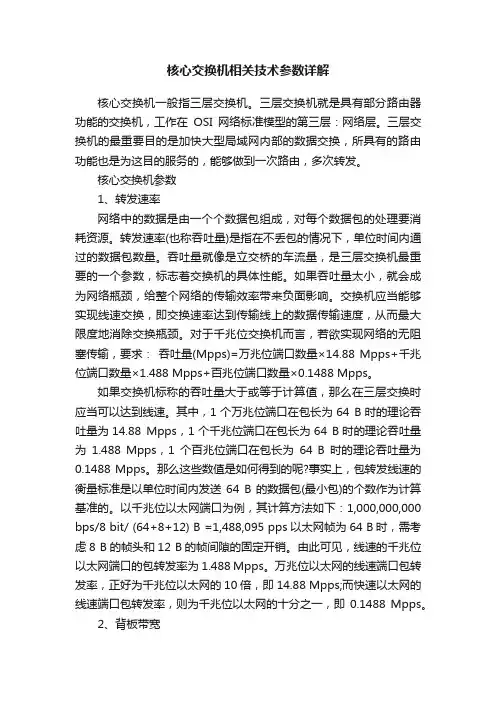
核心交换机相关技术参数详解核心交换机一般指三层交换机。
三层交换机就是具有部分路由器功能的交换机,工作在OSI网络标准模型的第三层:网络层。
三层交换机的最重要目的是加快大型局域网内部的数据交换,所具有的路由功能也是为这目的服务的,能够做到一次路由,多次转发。
核心交换机参数1、转发速率网络中的数据是由一个个数据包组成,对每个数据包的处理要消耗资源。
转发速率(也称吞吐量)是指在不丢包的情况下,单位时间内通过的数据包数量。
吞吐量就像是立交桥的车流量,是三层交换机最重要的一个参数,标志着交换机的具体性能。
如果吞吐量太小,就会成为网络瓶颈,给整个网络的传输效率带来负面影响。
交换机应当能够实现线速交换,即交换速率达到传输线上的数据传输速度,从而最大限度地消除交换瓶颈。
对于千兆位交换机而言,若欲实现网络的无阻塞传输,要求:吞吐量(Mpps)=万兆位端口数量×14.88 Mpps+千兆位端口数量×1.488 Mpps+百兆位端口数量×0.1488 Mpps。
如果交换机标称的吞吐量大于或等于计算值,那么在三层交换时应当可以达到线速。
其中,1个万兆位端口在包长为64 B时的理论吞吐量为14.88 Mpps,1个千兆位端口在包长为64 B时的理论吞吐量为1.488 Mpps,1个百兆位端口在包长为64 B时的理论吞吐量为0.1488 Mpps。
那么这些数值是如何得到的呢?事实上,包转发线速的衡量标准是以单位时间内发送64 B的数据包(最小包)的个数作为计算基准的。
以千兆位以太网端口为例,其计算方法如下:1,000,000,000 bps/8 bit/ (64+8+12) B =1,488,095 pps以太网帧为64 B时,需考虑8 B的帧头和12 B的帧间隙的固定开销。
由此可见,线速的千兆位以太网端口的包转发率为1.488 Mpps。
万兆位以太网的线速端口包转发率,正好为千兆位以太网的10倍,即14.88 Mpps;而快速以太网的线速端口包转发率,则为千兆位以太网的十分之一,即0.1488 Mpps。
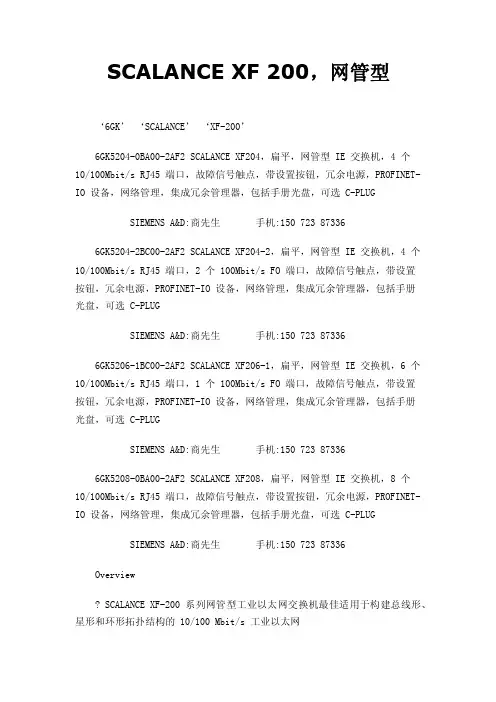
SCALANCE XF 200,网管型‘6GK’‘SCALANCE’‘XF-200’6GK5204-0BA00-2AF2 SCALANCE XF204,扁平,网管型 IE 交换机,4 个10/100Mbit/s RJ45 端口,故障信号触点,带设置按钮,冗余电源,PROFINET-IO 设备,网络管理,集成冗余管理器,包括手册光盘,可选 C-PLUGSIEMENS A&D:商先生手机:150****73366GK5204-2BC00-2AF2 SCALANCE XF204-2,扁平,网管型 IE 交换机,4 个10/100Mbit/s RJ45 端口,2 个 100Mbit/s FO 端口,故障信号触点,带设置按钮,冗余电源,PROFINET-IO 设备,网络管理,集成冗余管理器,包括手册光盘,可选 C-PLUGSIEMENS A&D:商先生手机:150****73366GK5206-1BC00-2AF2 SCALANCE XF206-1,扁平,网管型 IE 交换机,6 个10/100Mbit/s RJ45 端口,1 个 100Mbit/s FO 端口,故障信号触点,带设置按钮,冗余电源,PROFINET-IO 设备,网络管理,集成冗余管理器,包括手册光盘,可选 C-PLUGSIEMENS A&D:商先生手机:150****73366GK5208-0BA00-2AF2 SCALANCE XF208,扁平,网管型 IE 交换机,8 个10/100Mbit/s RJ45 端口,故障信号触点,带设置按钮,冗余电源,PROFINET-IO 设备,网络管理,集成冗余管理器,包括手册光盘,可选 C-PLUGSIEMENS A&D:商先生手机:150****7336OverviewSCALANCE XF-200 系列网管型工业以太网交换机最佳适用于构建总线形、星形和环形拓扑结构的 10/100 Mbit/s 工业以太网可使用集成冗余管理器构建具快速介质冗余性的快速以太网环形拓扑结构站或网络的电气和光学接口与设备的端口类型一致。
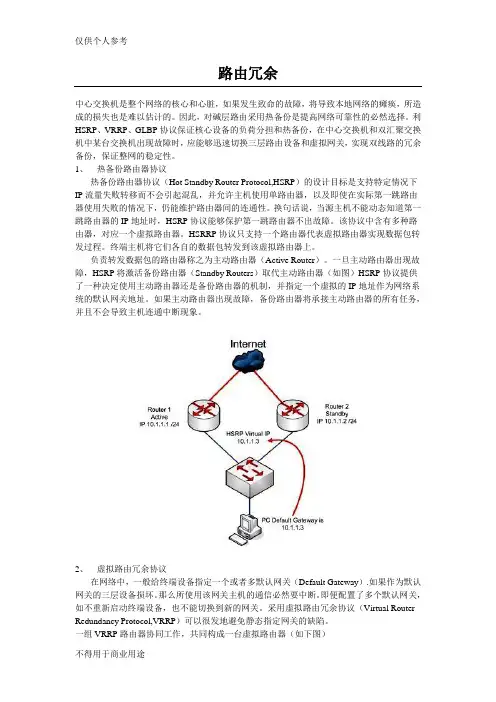
路由冗余中心交换机是整个网络的核心和心脏,如果发生致命的故障,将导致本地网络的瘫痪,所造成的损失也是难以估计的。
因此,对碱层路由采用热备份是提高网络可靠性的必然选择。
利HSRP、VRRP、GLBP协议保证核心设备的负荷分担和热备份,在中心交换机和双汇聚交换机中某台交换机出现故障时,应能够迅速切换三层路由设备和虚拟网关,实现双线路的冗余备份,保证整网的稳定性。
1、热备份路由器协议热备份路由器协议(Hot Standby Router Protocol,HSRP)的设计目标是支持特定情况下IP流量失败转移而不会引起混乱,并允许主机使用单路由器,以及即使在实际第一跳路由器使用失败的情况下,仍能维护路由器间的连通性。
换句话说,当源主机不能动态知道第一跳路由器的IP地址时,HSRP协议能够保护第一跳路由器不出故障。
该协议中含有多种路由器,对应一个虚拟路由器。
HSRRP协议只支持一个路由器代表虚拟路由器实现数据包转发过程。
终端主机将它们各自的数据包转发到该虚拟路由器上。
负责转发数据包的路由器称之为主动路由器(Active Router)。
一旦主动路由器出现故障,HSRP将激活备份路由器(Standby Routers)取代主动路由器(如图)HSRP协议提供了一种决定使用主动路由器还是备份路由器的机制,并指定一个虚拟的IP地址作为网络系统的默认网关地址。
如果主动路由器出现故障,备份路由器将承接主动路由器的所有任务,并且不会导致主机连通中断现象。
2、虚拟路由冗余协议在网络中,一般给终端设备指定一个或者多默认网关(Default Gateway).如果作为默认网关的三层设备损坏。
那么所使用该网关主机的通信必然要中断。
即便配置了多个默认网关,如不重新启动终端设备,也不能切换到新的网关。
采用虚拟路由冗余协议(Virtual Router Redundancy Protocol,VRRP)可以很发地避免静态指定网关的缺陷。
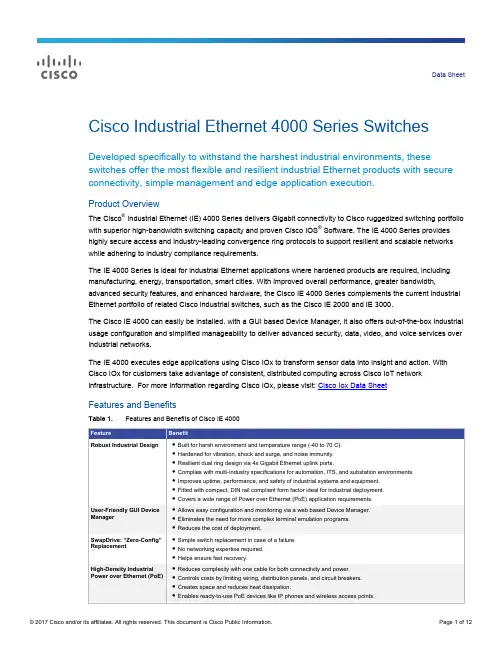
Data SheetCisco Industrial Ethernet 4000 Series Switches Developed specifically to withstand the harshest industrial environments, these switches offer the most flexible and resilient industrial Ethernet products with secure connectivity, simple management and edge application execution.Product OverviewThe Cisco® Industrial Ethernet (IE) 4000 Series delivers Gigabit connectivity to Cisco ruggedized switching portfolio with superior high-bandwidth switching capacity and proven Cisco IOS® Software. The IE 4000 Series provides highly secure access and industry-leading convergence ring protocols to support resilient and scalable networks while adhering to industry compliance requirements.The IE 4000 Series is ideal for industrial Ethernet applications where hardened products are required, including manufacturing, energy, transportation, smart cities. With improved overall performance, greater bandwidth, advanced security features, and enhanced hardware, the Cisco IE 4000 Series complements the current industrial Ethernet portfolio of related Cisco industrial switches, such as the Cisco IE 2000 and IE 3000.The Cisco IE 4000 can easily be installed. with a GUI based Device Manager, it also offers out-of-the-box industrial usage configuration and simplified manageability to deliver advanced security, data, video, and voice services over industrial networks.The IE 4000 executes edge applications using Cisco IOx to transform sensor data into insight and action. With Cisco IOx for customers take advantage of consistent, distributed computing across Cisco IoT network infrastructure. For more information regarding Cisco IOx, please visit: Cisco Iox Data SheetFeatures and BenefitsTable 1. Features and Benefits of Cisco IE 4000Your Ruggedized Choice for Industrial EnvironmentsThe Cisco Industrial Ethernet (IE) 4000 Series offers:●Bandwidth and capacity to grow with your networking needs: 20-Gbps nonblocking switching capacity withup to 20 Gigabit Ethernet ports per switch●High-density industrial PoE/PoE+ support providing in-line power to up to 8 power devices, including IPcameras and phones, badge readers, wireless access points, etc.●Cisco IOS Software features for smooth IT integration and policy consistency●Robust resiliency enabled by dual ring design via 4x Gigabit Ethernet uplink ports, Resilient EthernetProtocol (REP), Parallel Redundancy Protocol (PRP), PROFINET– Media Redundancy Protocol (MRP) ring, High Availability Seamless Redundancy (HSR) ring, Etherchannel and Flexlink support, redundant power input, dying gasp, etc.●True zero-touch replacement for middle-of-the-night or middle-of-nowhere failure●Line-rate, low-latency forwarding with advanced hardware assist features (such as NAT, IEEE1588)●Simplified software upgrade path with universal images●Support of Industrial automation protocols EtherNet/IP (CIP), PROFINET, and Modbus TCPFigure 1 shows switch models, Table 2 shows all the available Cisco IE 4000 Series models, Table 3 lists the SW license PIDs, and Table 4 lists the power supplies for Cisco IE 4000 Series Switches.Figure 1. IE 4000 ModelsTable 2. Cisco IE 4000 Series Models1 Combo ports provide one copper and one fiber physical port and only one can be activated at a time.2 Can be upgraded to IP Services at a fee.All copper Gigabit Ethernet interfaces support speed negotiation to 10/100/1000 mbps and duplex negotiation. All copper Fast Ethernet interfaces support speed negotiation to 10/100 mbps and duplex negotiation.Table 3. Cisco IE 4000 Software Licenses and Accessories PIDsTable 4. Power Supplies for Cisco IE 4000 Series Switches1 The entire power budget for the switch and PoE ports needs to stay within 170W. A PoE port draws up to 15.4W of power, anda PoE+ port draws up to 30W of power.2 The entire power budget for the switch and PoE ports needs to stay within 65W.Figure 2 shows a diagram to help you select a Cisco IE 4000 model.Figure 2. Cisco IE 4000 Model Selection GuideProduct SpecificationsTable 5 lists specifications, Table 6 gives information about switch performance and scalability, Table 7 and 8 list important software features, Table 9 lists compliance specifications, Table 10 gives information about management and standards of the Cisco IE 4000 Series Switches, and Table 11 shows the list of supported SFPs.Table 5. Product SpecificationsTable 6. Switch Performance and ScalabilityTable 7. Cisco IE 4000 LAN BASE: Key Software Features1 Support after product General AvailabilityTable 8. Cisco IE 4000 IP Services: Key Software FeaturesTable 9. Compliance SpecificationsKN24EN 61000-4-2 Electro Static DischargeEN 61000-4-3 Radiated RFEN 61000-4-4 Electromagnetic Fast TransientsN 61000-4-5 SurgeEN 61000-4-6 Conducted RFEN 61000-4-8 Power Frequency Magnetic FieldEN 61000-4-9 Pulse Magnetic FieldEN 61000-4-11 AC Power VoltageEN 61000-4-18 Damped Oscillatory WaveEN-61000-4-29 DC Voltage DipsIndustry Standards EN 61000-6-1 Light Industrial EN 61000-6-2 IndustrialEN 61000-6-4 IndustrialEN 61326 Industrial ControlEN 61131-2 Programmable ControllersSubstation KEMA (IEEE 1613, IEC 61850-3)Marine DNVNEMA TS-2 (EMC, environmental, mechanical)IEEE 1613 Electric Power Stations Communications NetworkingIEC 61850-3 Electric Substations Communications NetworkingEN50155 Railway - Electronic Equipment on Rolling Stock (EMC, ENV, Mech)EN50121-4 Railway - Signaling and Telecommunications ApparatusEN50121-3-2 Railway - Apparatus for Rolling Stock ODVA Industrial EtherNet/IPPROFINET conformance BIP30 (per EN60529)Safety Standards and Certifications Information Technology Equipment:UL/CSA 60950-1EN 60950-1CB to IEC 60950-1 with all country deviationsNOM to NOM-019-SCFI (through partners and distributor)Industrial Floor (Control Equipment):UL 508CSA C22.2, No 142Hazardous Locations:ANSI/ISA 12.12.01 CSA C22.2 No 213IEC 60079-0, -15 IECEx test reportEN 60079-0, -15 ATEX certification (Class I Zone 2) Cabinet enclosure requiredOperating Environment Operating Temperature: -40C to +75C●-40C to +70C (Vented Enclosure Operating)●-40C to +60C (Sealed Enclosure Operating)●-34C to +75C (Fan or Blower equipped Enclosure Operating)EN 60068-2-1EN 60068-2-2EN 61163Altitude: up to 15,000 feetStorage Environment Temperature: -40 to +85 degrees CAltitude: 15,000 feetIEC 60068-2-14Humidity Relative humidity of 5% to 95% non-condensingIEC 60068-2-3IEC 60068-2-30Shock and Vibration IEC 60068-2-27 (operational shock, 50G, 11ms, Half Sine)IEC 60068-2-27 (Non-Operational Shock, 65-80G, 9ms, Trapezoidal)IEC 60068-2-6, IEC 60068-2-64, EN 61373 (Operational Vibration)IEC 60068-2-6, IEC 60068-2-64, EN 61373 (Non-operational Vibration)Table 10. Management and Standards Description SpecificationIEEE Standards ●IEEE 802.1D MAC Bridges, STP●IEEE 802.1p Layer2 COS prioritization●IEEE 802.1q VLAN●IEEE 802.1s Multiple Spanning-Trees●IEEE 802.1w Rapid Spanning-Tree●IEEE 802.1x Port Access Authentication●IEEE 802.1AB LLDP●IEEE 802.3ad Link Aggregation (LACP)●IEEE 802.3af Power over Ethernet provides up to15.4W DC power to each end device●IEEE 802.3at Power over Ethernet provides up to25.5W DC power to each end device ●IEEE 802.3af Power over Ethernet●IEEE 802.3at Power over Ethernet Plus●IEEE 802.3ah 100BASE-X SMF/MMF only ●IEEE 802.3x full duplex on 10BASE-T●IEEE 802.3 10BASE-T specification●IEEE 802.3u 100BASE-TX specification●IEEE 802.3ab 1000BASE-T specification ●IEEE 802.3z 1000BASE-X specification●IEEE 1588v2 PTP Precision Time Protocol ●IEEE 802.1AS PTP●IEEE 802.1Qbv TSNRFC Compliance ●RFC 768: UDP●RFC 783: TFTP●RFC 791: IPv4 protocol●RFC 792: ICMP●RFC 793: TCP●RFC 826: ARP●RFC 854: Telnet●RFC 951: BOOTP●RFC 959: FTP●RFC 1157: SNMPv1●RFC 1901,1902-1907 SNMPv2●RFC 2273-2275: SNMPv3●RFC 2571: SNMP Management●RFC 1166: IP Addresses●RFC 1256: ICMP Router Discovery ●RFC 1305: NTP●RFC 1492: TACACS+●RFC 1493: Bridge MIB Objects●RFC 1534: DHCP and BOOTP interoperation●RFC 1542: Bootstrap Protocol●RFC 1643: Ethernet Interface MIB●RFC 1757: RMON●RFC 2068: HTTP●RFC 2131, 2132: DHCP●RFC 2236: IGMP v2●RFC 3376: IGMP v3●RFC 2474: DiffServ Precedence●RFC 3046: DHCP Relay Agent Information Option ●RFC 3580: 802.1x RADIUS●RFC 4250-4252 SSH ProtocolSNMP MIB Objects ●BRIDGE-MIB●CALISTA-DPA-MIB●CISCO-ACCESS-ENVMON-MIB●CISCO-ADMISSION-POLICY-MIB●CISCO-AUTH-FRAMEWORK-MIB●CISCO-BRIDGE-EXT-MIB●CISCO-BULK-FILE-MIB●CISCO-CABLE-DIAG-MIB●CISCO-CALLHOME-MIB●CISCO-CAR-MIB●CISCO-CDP-MIB●CISCO-CIRCUIT-INTERFACE-MIB●CISCO-CLUSTER-MIB●CISCO-CONFIG-COPY-MIB●CISCO-CONFIG-MAN-MIB●CISCO-DATA-COLLECTION-MIB●CISCO-DHCP-SNOOPING-MIB●CISCO-EMBEDDED-EVENT-MGR-MIB●CISCO-ENTITY-ALARM-MIB●CISCO-ENTITY-SENSOR-MIB●CISCO-ENTITY-VENDORTYPE-OID-MIB●CISCO-ENVMON-MIB●CISCO-ERR-DISABLE-MIB●CISCO-FLASH-MIB●CISCO-FTP-CLIENT-MIB●CISCO-IF-EXTENSION-MIB●CISCO-IGMP-FILTER-MIB●CISCO-IMAGE-MIB●CISCO-IP-STAT-MIB●CISCO-LAG-MIB●CISCO-LICENSE-MGMT-MIB●CISCO-MAC-AUTH-BYPASS-MIB●CISCO-MAC-NOTIFICATION-MIB●CISCO-MEMORY-POOL-MIB●CISCO-PAE-MIB●CISCO-PAGP-MIB●CISCO-PING-MIB●CISCO-PORT-QOS-MIB●CISCO-PORT-SECURITY-MIB●CISCO-PORT-STORM-CONTROL-MIB●CISCO-PRIVATE-VLAN-MIB●CISCO-PROCESS-MIB●CISCO-PRODUCTS-MIB●CISCO-RESILIENT-ETHERNET-PROTOCOL-MIB●CISCO-RTTMON-ICMP-MIB●CISCO-RTTMON-IP-EXT-MIB●CISCO-RTTMON-MIB●CISCO RTTMON-RTP-MIB ●CISCO RTTMON-RTP-MIB●CISCO-SNMP-TARGET-EXT-MIB●CISCO-STACK-MIB●CISCO-STACKMAKER-MIB●CISCO-STP-EXTENSIONS-MIB●CISCO-SYSLOG-MIB●CISCO-TCP-MIB●CISCO-UDLDP-MIB●CISCO-VLAN-IFTABLE-RELATIONSHIP-MIB ●CISCO-VLAN-MEMBERSHIP-MIB●CISCO-VTP-MIB●ENTITY-MIB●ETHERLIKE-MIB●HC-RMON-MIB●IEEE8021-PAE-MIB●IEEE8023-LAG-MIB●IF-MIB●IP-FORWARD-MIB●LLDP-EXT-MED-MIB●LLDP-EXT-PNO-MIB●LLDP-MIB●NETRANGER●NOTIFICATION-LOG-MIB●OLD-CISCO-CHASSIS-MIB●OLD-CISCO-CPU-MIB●OLD-CISCO-FLASH-MIB●OLD-CISCO-INTERFACES-MIB●OLD-CISCO-IP-MIB●OLD-CISCO-MEMORY-MIB●OLD-CISCO-SYS-MIB<●OLD-CISCO-SYSTEM-MIB●OLD-CISCO-TCP-MIB●OLD-CISCO-TS-MIB●RMON-MIB●RMON2-MIB●SMON-MIB●SNMP-COMMUNITY-MIB●SNMP-FRAMEWORK-MIB●SNMP-MPD-MIB●SNMP-NOTIFICATION-MIB●SNMP-PROXY-MIB●SNMP-TARGET-MIB●SNMP-USM-MIB●SNMP-VIEW-BASED-ACM-MIB●SNMPv2-MIB●TCP-MIB●UDP-MIBTable 11. SFP SupportNote: Not all SFPs supported in all SW versions. For first software release supporting SFP refer to https:///en/US/products/hw/modules/ps5455/products_device_support_tables_list.htmlNot all SFPs are supported in PROFINET GSD, SIMATIC STEP7/TIA Portal, please visithttps:///c/en/us/td/docs/switches/lan/industrial/software/configuration/guide/b_sfp_TIA.html * If non industrial (i.e., EXT, COM) SFPs are used the switch operating temperature must be derated.MMF = multi-mode fiberSMF = single-mode fiberFigure 3 shows IE4000 mechanical dimensionsFigure 3. IE-4000Warranty InformationWarranty information for the IE 4000 is available on /warrantyfinder.aspx. Cisco CapitalFinancing to Help You Achieve Your ObjectivesCisco Capital can help you acquire the technology you need to achieve your objectives and stay competitive. We can help you reduce CapEx. Accelerate your growth. Optimize your investment dollars and ROI. Cisco Capital financing gives you flexibility in acquiring hardware, software, services, and complementary third-party equipment. And there’s just one predictable payment. Cisco Capital is available in more than 100 countries. Learn more.Printed in USA C78-733058-13 11/17。
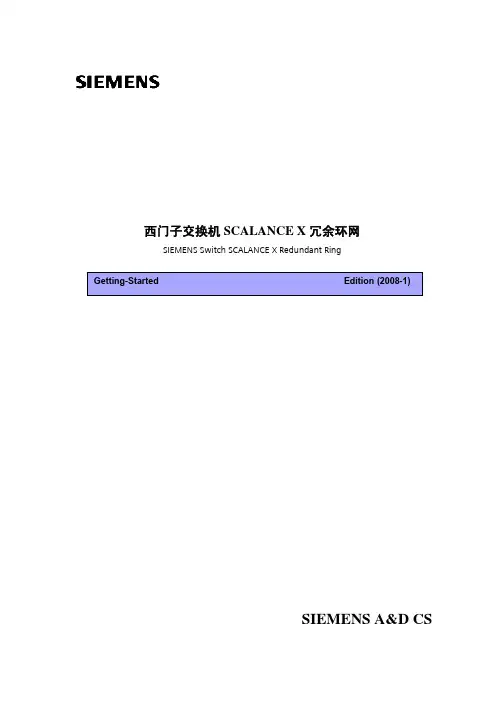
西门子交换机 SCALANCE X 冗余环网SIEMENS Switch SCALANCE X Redundant RingGetting-StartedEdition (2008-1)SIEMENS A&D CS摘 要 随着工业以太网的广泛应用,工业控制对以太网的冗余技术要求也不断提高.西门子 工业级交换机 SCALANCE X400/300/200 以及 OSM/ESM 支持高速的冗余环网,即 HSR (High Speed Ring) .另外还支持环与环之间的 STBY 的热备连接,构建环与环之间的冗余路径.这 些都增加了网络系统的可靠性.由于 SCALANCE X 交换机配置 HSR 和 STBY 的方式是类似 的,所以本文例举西门子交换机 SCALANCE X400,通过配置 HSR 和 STBY 组态,帮助用户快 速的了解 HSR/STBY 和配置 HSR/STBY. 关键词 西门子交换机,SCALANCE X,高速冗余环网,环网间热备,冗余管理器 Key Words SIEMENS Switch, SCALANCE X, HSR, STBY, RM (Redundancy manager)A&D Service & SupportPage 2-8冗余环网,各台交换机通过冗余环口依次进行连接,如下图高速冗余环网HSR. SCALANCE X400可以作为冗余管理器RM,管理冗余环网,为了保证系统的快速重构和稳定 性最多50个交换机连接在环上.除了其它交换机需要设置冗余环口,在网络正常的情况下, RM的其中的一个冗余环口会处于断开状态.这样整个网络处于一种线型结构.冗余管理器监 控网络状态,当网络上的连接线断开或交换机故障,它会通过一个替代路径恢复另外一种线 型结构.整个网络的重构时间小于0.3秒.如果问题被消除,会恢复原有的线型结构.在一个 环网中,只能存在一个交换机组成冗余管理器.环网可以是电气环网也可以是光纤环网,也 可以是电气和管线混合的环网.另外,可以利用SCALANCE X 400的千兆端口,组成高速冗余 的千兆环网.AB高速冗余环网 HSR环间热备 STBY环网之间的冗余备份 STBY,通过两台交换机各自连接到另外一个环网的两台交换机,如 上图环间热备 STBY.仅需要在同一个环网中的两个交换机 A 和 B(与另外一个环网进行冗余 连接)进行组态,即可完成环网之间的连接冗余.这两个交换机 A 和 B 通过网络相互交换数 据来同步它们的运行状态,其中一台设备作为 Master,另外一台设备作为 Slave.在网络正 常的情况下,仅是 Master 与另外一个环网的连接是激活的,即通讯数据通过该连接完成两个 环网之间的通讯.如果 Master 的连接断开或 Master 交换机故障,这时 Salve 会激活其连 接,这时两个环网之间的数据就通过 Slave 的连接来完成.如果故障恢复,Master 会重新作 为环网之间的激活连接.STBY 可以是电气连接也可以是光纤连接.另外,可以利用 SCALANCE X 408 的千兆端口,组成千兆环网冗余热备.A&D Service & SupportPage 3-8SCALANCE X 400冗余环网组态: 配置 RM 对于 SCALANCE X414-3E,可以使用 Slot 4 上 CPU 的 DIP 开关,具体方式如下: 交换机 RM STBY 状态 OFF ON 意义 SCALANCE X414-3E 不作为 RM SCALANCE X414-3E 作为 RM 该功能无效,需要软件配置.当 R1 和 R2 的 DIL 开关都为 ON 状态,也可以使用 Web 页面来设置.点击目录树 X400 Ring Config,使能 Redundancy Manager(RM) enabled.配置 RM对于 SCALANCE X408,仅需要通过 Web 页面来设置.点击目录树 X-400 Ring Config, 使能 Redundancy Manager(RM) enabled.点击 Set Values 按钮结束设置.A&D Service & SupportPage 4-8配置 环口环网中设置完毕 RM 后,所有的交换机 SCALANCE X414-3 都需要同时设置环口.设置环口 可以通过 CPU 槽上 DIL 开关来设置,具体方式如下: 交换机 R1 R2 R1 R2 R1 R2 R1 R2 状态 OFF OFF ON OFF OFF ON ON ON 意义 Slot5 槽上的千兆端口作为环口. Slot6 槽上的端口 1,2 作为环口. Slot6 槽上的端口 1 是环口,Slot7 槽上的端口 1 是环口. 禁止 DIL 设置环网冗余.当 R1 和 R2 的 DIL 开关都为 ON 状态,也可以使用 Web 页面来设置.点击目录树 X400 Ring Config,使能 Ring Redundancy enabled 并选择环网连接的环口.点击 Set Values 按钮结束设置. 这样 SCALANCE X414-3E 作为 RM 的组态如下:非 RM 的 SCALACNE X414-3E 的组态如下:A&D Service & SupportPage 5-8配置 环口对于 SCALANCE X408,仅需要通过 Web 页面来设置.点击目录树 X-400 Ring Config, 使能 Ring Redundancy enabled 并选择环网连接的环口.点击 Set Values 按钮结束设置. 这样 SCALANCE X408 作为 RM 的组态如下:非 RM 的 SCALACNE X408 的组态如下:SCALANCE X 400 环网间热备组态:A&D Service & SupportPage 6-8配置 STBY参考上图,环间热备 STBY,对于 SCALANCE X400,热备另外一个环仅需要设置在同一个 环网中的两个交换机 A 和 B 进行组态,即可完成环网之间的连接冗余.SCALANCE X 400 通过 Web 页面来设置.对于 A 和 B,点击目录树 X-400 Standby Mask,使能 Standby Connection enabled.设置名字 STBY(可任意设置),不过两台交换机 A 和 B 需要设置相 同的名字,需要注意大小写,不过同一环网中只能有一对交换机使用这个名字,可以有多 对用于环网间热备,每一组(对)拥有不同于其它组唯一的名字.然后使能 STBY 环口监 视,通过该端口连接另外一个环.A 是 Port11.1,B 是 Port10.2.A 和 B 可以使用不同的端 口来连接另外一个环.交换机 A 的 STBY 组态:交换机 B 的 STBY 组态:MAC 地址大的交换机为 Master.A&D Service & Support Page 7-8附录-推荐网址NET 西门子(中国)有限公司 自动化与驱动集团 客户服务与支持中心 网站首页:/Service/ 专家推荐精品文档:/Service/recommend.asp Net常问问题:/CN/view/zh/10805868/133000 Net更新信息:/CN/view/zh/10805868/133400 "找答案"Net版区: /service/answer/category.asp?cid=1031A&D Service & SupportPage 8-8。
基于 PRP和 HSR的无缝冗余通信技术摘要对于常用的通讯技术而言,一个通讯的终端需要有PRP协议以及HSR 协议构成,这一才可以保证有效的与另一端的网络设备的通讯。
同时,终端还可以通过网络技术借助复数的形式,将数据包按照不同的路径进行传送,要是有一端的单一通信链路发生故障无法完成通讯时,就可以借助备用数据包完成数据的送达,从而实现数据的冗余通信。
并且,使用了PRP协议以及HSR协议的通讯技术能够是得在通讯系统中的中断的消耗时间为0,这样就可以保证传输的有效,保证传输数据的完整。
关键字:PRP;HSR;冗余通信技术前言在本文中,主要想要介绍一项新的创新项目,同时在本项目中,希望能够实现无缝的冗余通信技术、冗余协议以及高可靠的冗余通信,所以就需要进行一系列的实验,进一步验证实验的可行性。
一、PRP与HSR的冗余协议PRP和HSR是不同的网络冗余协议,但是基本原理又非常的相似。
同时两者都可以很好地适应多种网络拓扑结构,并且还能够通过利用链路层的冗余单元对上层应用实现透明,从而达到理想中的冗余效果。
1.PRP协议原理PRP协议要想实现冗余效果,就需要借助一些能够支持PRP的网络节点的协助,同时,一些网络节点能够支持PRP的,都需要拥有两个独立的运行端口,并且这两个端口还可以进行独立的工作,能够独立的与局域网进行连接。
这就会使得在使用的过程中,PRP网络节点将报文复制成两份,发送给两个不同的局域网中的节点里。
对于任意一个独立的网络出现故障时,并不会影响到PRP网络节点接收到报文的功能,因此就可以实现冗余通信。
1.HSR协议原理HRS协议能够实现冗余通信的原理与PRP协议类似,但是HRS协议主要是依靠两个物理端口,才可以为系统提供冗余通信。
并且HRS的网络结构类似一个环形,在运行的过程中,就需要借助HRS的网络节点对两个端口同时发送报文。
1并且在运行的过程中,首先需要判断报文是否是广播帧,如果判断出报文是广播帧,就会进行接受以及转发;若是判断出报文不是广播帧,则会自动检查链路地址是否正确,从而实现冗余通信。
核心交换机参数配置说明1.VLAN配置:VLAN是虚拟局域网的缩写,将不同的用户或设备划分到不同的虚拟网络中,可以提高安全性和灵活性。
核心交换机应配置VLAN,并将不同的用户或设备划分到相应的VLAN中,确保不同的用户或设备之间的数据隔离。
2.端口聚合配置:端口聚合将多个物理端口绑定成一个逻辑端口,提高带宽利用率和可靠性。
核心交换机应配置端口聚合,并将需要聚合的物理端口进行绑定,确保数据可以在多个物理链路之间进行负载均衡和冗余备份。
3.QoS配置:QoS(Quality of Service)是服务质量的缩写,可以提供不同的服务质量保证。
核心交换机应配置QoS,根据不同类型的流量进行优先级设置和带宽分配,确保网络中的关键应用能够获得所需的带宽和低延迟。
4.路由配置:5.安全配置:6.可靠性配置:核心交换机应配置相应的可靠性功能,以保证网络的稳定性和可用性。
可靠性配置可以包括冗余路径的设置、冗余电源的配置、冗余风扇的设置等,确保在设备故障或链路故障时能够自动切换到备份路径或备份设备,从而避免网络中断。
7.监控配置:8.日志配置:9.SNMP配置:SNMP(Simple Network Management Protocol)是网络管理的标准协议,可以实现对核心交换机的远程监控和管理。
核心交换机应配置SNMP,设置SNMP服务的开启和参数配置,确保网络管理员可以通过SNMP管理软件对交换机进行远程监控和管理。
总结:核心交换机的参数配置对于网络的性能和稳定性具有重要影响。
正确的配置可以提高网络的安全性、可用性和性能,确保网络能够正常运行并满足用户的需求。
在进行核心交换机参数配置时,需要根据具体的网络环境和需求进行合理的选择和设置,同时还需要定期进行监控和维护,确保配置的有效性和稳定性。
区域保护控制系统网络拓扑研究杨贵;彭安;李莉【摘要】为解决区域保护控制系统分布式业务的对等通信需求,实现变电站间保护业务的对等通信机制,在现有电力系统多业务传输平台(multi-service transfer platform,MSTP)组网结构基础上研究基于MSTP的对等通信网络拓扑实现方案;同时研究适用于电力系统分组传送网(packet transport network,PTN)的对等通信网络拓扑实现方案;为了弥补MSTP网络环网保护的缺陷,研究了基于高可靠性无缝冗余(high-availability seamless redundancy,HSR)环网技术的对等通信实现方案,并对各种方案进行对比,为将来区域保护控制系统的网络建设提供了有益指导.【期刊名称】《江苏电机工程》【年(卷),期】2016(035)003【总页数】5页(P1-4,9)【关键词】区域保护控制;对等通信;高可靠性无缝冗余;多业务传输平台;分组传送网【作者】杨贵;彭安;李莉【作者单位】南京南瑞继保电气有限公司,江苏南京211102;南京南瑞继保电气有限公司,江苏南京211102;南京南瑞继保电气有限公司,江苏南京211102【正文语种】中文【中图分类】TM77随着社会经济的发展,人们对电力的需求和依赖越来越大,对供电质量的要求也越来越高,对于核心业务要求不间断供电。
然而,随着互联电网区域的扩大、交换容量的增加及电网电压等级的提高,由互联电网故障引起的特大停电事故几乎成为社会灾难,停电造成的损失也越来越大。
保障互联电网的运行安全性,避免重大停电事故的发生变得越来越困难。
现有的电力系统三道防线[ 1,2 ]已无法满足日益提供的供电可靠性要求。
为了有效提升电力系统的整体供电可靠性,需要改变现有的后备保护模式,采用主动收集相关变电站信息的方式加快后备保护及稳定控制动作时间[ 3 ],从而达到实现提升供电质量的最终目标。
区域保护与控制系统是基于这种目的而诞生的保护控制系统。
Huawei S9300E Switch Product BrochuresHuawei S9300E series (S9300E for short) terabit routing switches are next-generation high-end smartswitches tailored for multiservice networks. The S9300E uses Huawei's intelligent multilayer switchingconcept to provide high-performance L2/L3 switching services as well as rich network applications suchas High-Definition (HD) video, elastic cloud computing, hardware IPv6, unified security, and H-QoS.and data centers to help carriers build application-centric networks.The S9300E is available in three models: S9303E, S9306E, and S9312E. All S9300E models use Huawei S9300E Switch Product Brochures Product OverviewAgile Switch, Enabling Networks to Be More Agile for Services• The high-speed ENP is tailored for Ethernet networks. The ENP's flexible packet processing and traffic controlcapabilities can meet current and future service requirements and help build a highly scalable network. TheENP has a fully programmable architecture, in which customers can define their own forwarding models,Product FeaturesS9303E S9306E S9312E S9300E can use most of the cards of S9300, protecting customer investment.1Huawei Sx300 Series Switchesforwarding behaviors, and lookup algorithms. Microcode programmability enables new services to beprovisioned within six months, without the need of replacing the hardware. In contrast, with traditionalASIC chips, new services cannot be provisioned until new hardware is developed to support the services,which may take 1 to 3 years, because ASIC chips use a fixed forwarding architecture and follow a fixedforwarding process.• By using an ENP board, the S9300E supports the unified user management function to authenticate bothwired and wireless users, ensuring a consistent user experience regardless of whether they use wiredor wireless access devices to connect to the network. The unified user management function supportsvarious authentication methods, including 802.1x, MAC, and Portal authentications, and is capableof managing users based on user groups, domains, and time ranges. This function visualizes user andservice management and enables the transformation from device-centric management to user-centricmanagement.• The ENP board supports the Packet Conservation Algorithm for Internet (iPCA) function, which changesthe traditional method of using simulated traffic for fault location. iPCA technology can monitor networkquality for any service flow at any network node, at any time, and without extra costs. It can detecttemporary service interruptions in a very short time and precisely identify faulty ports. This cutting-edgefault detection technology turns "extensive management" to "fine granular management."• Huawei's IEEE 1588v2 and Synchronous Ethernet (SyncE) solutions enable high-precision timesynchronization between network devices. Compared with the Global Positioning System (GPS) timesynchronization solution, Huawei's solutions enhance security while reducing costs.Innovative CSS Technology• The S9300E supports the CSS function to virtualizes multiple devices into one, significantly improvingswitch reliability, switching efficiency, flexibility, and manageability.• The S9300E uses route hot backup technology to back up and uninterruptedly forward all data of thecontrol and data planes at Layer 3. This technology significantly improves reliability and performance ofthe S9300E. The inter-chassis links in a CSS can be bundled to improve link use efficiency and eliminatesingle-point failures.• The S9300E can use common service ports as cluster ports, and member switches can be connectedthrough optical fibers. This increases the permitted distance between switches in the CSS.• All member switches in a CSS are managed through a single IP address, which simplifies network deviceand topology management, improves network operation efficiency, and reduces maintenance costs.Carrier-Class Reliability• The S9300E's key components, such as MPUs, power supplies, and fans trays, use a redundant design,and all modules are hot swappable to ensure stable network running.• The S9300E supports 3.3 ms hardware-based BFD for static routes and routing protocols such as RIP,OSPF, BGP, IS-IS, VRRP, PIM, and MPLS. Hardware-based BFD significantly improves network reliability.2Huawei Sx300 Series Switches• The S9300E supports High-speed Self Recovery (HSR) technology. Using Huawei's ENP cards, the S9300Eis the industry's only switch that implements end-to-end IP MPLS bearer network protection switchover within 50 ms, improving network reliability.• The S9300E supports hardware-based Ethernet OAM in compliance with IEEE 802.3ah, 802.1ag, andITU-Y. 1731. Hardware-based Ethernet OAM can collect precise network parameters, such as transmission latency and jitter, to help customers monitor network operating status in real time and to realize fast fault detection, location, and failover.• The S9300 supports Graceful Restart (GR) technology to implement nonstop forwarding (NSF) and ensure reliable and high-speed operation of the entire network.Powerful Service Processing Capabilities• Based on a multi-service routing and switching platform, the S9300E provides wireless access, voice, video, and data services for network access, aggregation, and core layers, helping customers build a highly reliable, low-latency, and multi-service network.• The S9300E supports distributed MPLS L2/L3VPN functions including MPLS, virtual private LAN service (VPLS), hierarchical VPLS (HVPLS), and virtual leased line (VLL), to provide secure access for VPN users.• The S9300E supports comprehensive Layer 2 and Layer 3 multicast protocols, including Protocol Independent Multicast Sparse Mode (PIM SM), PIM Dense Mode (DM), PIM Source-Specific Multicast (SSM), Multicast Listener Discovery (MLD), and Internet Group Management Protocol (IGMP) snooping, to ensure high-quality HD video surveillance and video conferencing services.• The Service Chain feature virtualizes the value-added service processing capabilities, such as firewall,so that campus networks can utilize these capabilities in an undifferentiated manner. That is, these capabilities can be used without location constraint.• The software platform where the S9300E runs supports various routing protocols (including IPv6) to meet carriers' network requirements and allows carriers to smoothly upgrade their networks to IPv6.Various Network Traffic Analysis Functions• The S9300E supports NetStream, including V5/V8/V9 versions. The NetStream features involve aggregation traffic template, real-time traffic sampling, dynamic report generation, traffic attribute analysis, and traffic exception alarms. The S9300E sends traffic statistics logs to master and backup servers simultaneously to avoid data loss. NetStream helps monitor the operating status and traffic model on the entire network.It also provides fault pre-detection, effective fault rectification, fast problem handling, and security monitoring capabilities to help customers optimize network structure and adjust service deployment. Comprehensive Security Measures• The S9300E supports MAC security (MACSec) that enables hop-by-hop secure data transmission.The S9300E can be applied to scenarios that pose high requirements on data confidentiality, such as government and finance sectors.Huawei Sx300 Series Switches3• NGFW is a next-generation firewall card installed on an S9300E. In addition to the traditional defensefunctions, such as identity authentication and Anti-DDoS, the NGFW supports IPS, anti-spam, web security,and application control functions.• The S9300E provides comprehensive network admission control (NAC) solutions, involving MAC, 802.1x,and Portal authentications as well as authentication triggered by DHCP snooping. These authenticationmethods ensure the security of various access users, such as dumb terminals, mobile users, and usersallocated dynamic IP addresses.Comprehensive IPv6 Solution• The S9300E software and hardware platforms support IPv6. The Ministry of Industry and InformationTechnology (MIIT) has certified the S9300E as IPv6 network-access compliant and has awarded IPv6 ReadyLogo Phase 2 certification.• The S9300E supports IPv6 routing protocols such as RIPng, OSPFv3, IS-ISv6, as well as IPv6 static routes,and supports BGP4+, MLD v1/v2, MLD snooping, PIM-SM/DMv6, and PIM-SSMv6.• The S9300E supports various IPv4-to-IPv6 technologies to ensure seamless network migration. Thetechnologies include IPv6 manual tunnel, 6to4 tunnel, Intra-site Automatic Tunnel Addressing Protocol(ISATAP) tunnel, Generic Routing Encapsulation (GRE) tunnel, and IPv4-compatible automatic tunnel.Innovative Energy Saving Design• The S9300E uses a rotating ventilation channel to improve heat dissipation efficiency and a variable-current chip to dynamically adjust power according to traffic volume. These technologies reduce powerconsumption of the entire chassis by 11%. The S9300E supports port sleeping. Idle ports enter thesleeping state to reduce power consumption.• The S9300E supports intelligent fan-speed adjustment, in which fans are grouped into multiple zonesand fan speed in each zone is adjusted individually based on service loads. This technology lowers powerconsumption, reduces noise, and extends the service life of fans.• The S9300E supports Energy Efficient Ethernet (EEE) in compliance with IEEE 802.3az. Transceivers on linecards can quickly transition to the lower power idle state to reduce power consumption when no traffic isbeing transmitted.4Huawei Sx300 Series SwitchesProduct Specifications5Huawei Sx300 Series Switches6Huawei Sx300 Series SwitchesHuawei Sx300 Series Switches7Product List8Huawei Sx300 Series SwitchesHuawei Sx300 Series Switches910Huawei Sx300 Series SwitchesHuawei Sx300 Series Switches1112Huawei Sx300 Series SwitchesHuawei Sx300 Series Switches1314Huawei Sx300 Series SwitchesHuawei Sx300 Series Switches15For more information, visit / or contact the Huawei local sales office.ApplicationsApplications in Carriers' MANsThe S9300E provides carrier-class reliability, security, and manageability. By converging DSLAM, LAN, andenterprise access services, the S9300E provides large-capacity switching and high-density 10G interfaces. At the convergence layer, the interface rate can be smoothly upgraded from 10GE to 40GE/100GE, meeting the increasing bandwidth requirements of ISP networks. The S9300E supports features such as RRPP , EthernetOAM, VRRP , and MPLS L2/L3VPN, and satisfies the requirements for IPTV, high speed Internet (HSI), andenterprise leased lines.Applications in Large-Scale Data CentersThe S9300E switches function as high-density 10G core and aggregation nodes in large-scale data centers, helping enterprises build highly reliable, non-blocking, and virtualized data center networks. The S9300Eswitches use various technologies, including IP FRR, hardware-level BFD, NSF, VRRP , and E-Trunk, to ensureuninterrupted services. In addition, the S9300E switches support the CSS function to improve network IT efficiency and reduce network maintenance costs.Softx AGIPTV Server VOD ServiceWeb & Email Application Application DatabaseS230016Huawei Sx300 Series SwitchesCopyright © Huawei Technologies Co., Ltd. 2017. All rights reserved.No part of this document may be reproduced or transmitted in any form or by any means without prior written consent of Huawei Technologies Co., Ltd.Trademark Notice, HUAWEI, and are trademarks or registered trademarks of Huawei Technologies Co., Ltd.Other trademarks, product, service and company names mentioned are the property of their respective owners.General DisclaimerThe information in this document may contain predictive statements including,without limitation, statements regarding the future financial and operating results,future product portfolio, new technology, etc. There are a number of factors thatcould cause actual results and developments to differ materially from thoseexpressed or implied in the predictive statements. Therefore, such information isprovided for reference purpose only and constitutes neither an offer nor anacceptance. Huawei may change the information at any time without notice.。
第42卷第21期电力系统保护与控制V ol.42 No.21 2014年11月1日Power System Protection and Control Nov. 1, 2014 IEC62439 PRP冗余丢弃算法设计张宪军,刘颖,余华武,陈新之(国电南京自动化股份有限公司,江苏 南京210003)摘要:智能变电站GOOSE、SV、MMS三网合一信息充分共享,双星型网架可靠性较高,相应电力装置需支持高效、健壮冗余丢弃算法。
针对PRP推荐双窗口丢弃算法较复杂、乱序报文效率较低、时序考量不严谨、无设备重启等异常处理,总结了丢弃算法基本要求,分析了时序可靠丢弃、安全接收原则,提出基于节点对节点链路序列号状态HASH算法和固定单滑动窗口相结合的方法。
详细分析起止点在与不在滑动窗口、接收序列号在窗口前中后情形,并给出算法伪码供借鉴使用。
健壮性指出超过一定时限,序列号相同,报文内容未必相同;在同一个时限内,FCS(帧校验序列)完全一样,报文内容未必相同。
本方法能快速准确判断丢弃接收重复报文,为智能变电站电力装置支持PRP/HSR奠定坚实算法基础。
关键词:IEC62439;PRP;HSR;丢弃算法;冗余;冗余设计;智能变电站;三网合一IEC62439 PRP redundancy discard algorithm designZHANG Xian-jun, LIU Ying, YU Hua-wu, CHEN Xin-zhi(Nanjing SAC Power Grid Automation Co., Ltd., Nanjing 210003, China)Abstract: Smart substation GOOSE, SV, MMS three-in-one network achieves full information sharing, the double star network reliability is high, the corresponding power device needs to support efficient and robust redundancy discarding algorithm. According to the PRP recommended double window drop algorithm is complex, disordered packet has low efficiency, timing considerations are not rigorous, restarting exception handling is not included, this paper summarizes the basic needs of discard algorithm, analyzes reliable discarded and safe receiving timing principle, proposes the sequence number state HASH algorithm and a single fixed sliding window method. A detailed analysis of the starting and ending points are or not in the sliding window, the receiving sequence number before or in or after the window situations, and gives the algorithm pseudo code for reference use. Robustness that exceeds specific interval, for the same sequence number, the content of the packet may not be the same; within specific interval, different packets may have the same FCS (frame check sequence). This method can assert and discard received duplicate packet quickly and accurately, which lays a solid basis for the power device of smart substation to realize PRP/HSR algorithm.Key words: IEC62439; PRP; HSR; discard algorithm; redundancy; redundancy design; smart substation; three network in one中图分类号:TM76 文献标识码:A 文章编号:1674-3415(2014)21-0110-060 引言智能变电站在GOOSE、SV、MMS三网合一测试中,核心交换机冗余备份较引人注目。
客户核心交换机HSRP配置说明
一、HSRP协议概述
实现HSRP的条件是系统中有多台路由器,它们组成一个“热备份组”,这个组形成一个虚拟路由器。
在任一时刻,一个组内只有一个路由器是活动的,并由它来转发数据包,如果活动路由器发生了故障,将选择一个备份路由器来替代活动路由器,但是在本网络内的主机看来,虚拟路由器没有改变。
所以主机仍然保持连接,没有受到故障的影响,这样就较好地解决了路由器切换的问题。
为了减少网络的数据流量,在设置完活动路由器和备份路由器之后,只有活动路由器和备份路由器定时发送HSRP报文。
如果活动路由器失效,备份路由器将接管成为活动路由器。
如果备份路由器失效或者变成了活动路由器,将有另外的路由器被选为备份路由器。
在实际的一个特定的局域网中,可能有多个热备份组并存或重叠。
每个热备份组模仿一个虚拟路由器工作,它有一个Well-known-MAC地址和一个IP地址。
该IP地址、组内路由器的接口地址、主机在同一个子网内,但是不能一样。
当在一个局域网上有多个热备份组存在时,把主机分布到不同的热备份组,可以使负载得到分担。
二、HSRP的工作原理
HSRP协议利用一个优先级方案来决定哪个配置了HSRP协议的路由器成为默认的主动路由器。
如果一个路由器的优先级设置的比所有其他路由器的优先级高,则该路由器成为主动路由器。
路由器的缺省优先级是100,所以如果只设置一个路由器的优先级高于100,则该路由器将成为主动路由器。
通过在设置了HSRP协议的路由器之间广播HSRP优先级,HSRP协议选出当前的主动路由器。
当在预先设定的一段时间内主动路由器不能发送hello消息时,优先级最高的备用路由器变为主动路由器。
路由器之间的包传输对网络上的所有主机来说都是透明的。
配置了HSRP协议的路由器交换以下三种多点广播消息:
l Hello———hello消息通知其他路由器发送路由器的HSRP优先级和状态信息,HSRP路由器默认为每3秒钟发送一个hello消息;
l Coup———当一个备用路由器变为一个主动路由器时发送一个coup消息;
l Resign———当主动路由器要宕机或者当有优先级更高的路由器发送hello消息时,主动路由器发送一个resign消息。
在任一时刻,配置了HSRP协议的路由器都将处于以下六种状态之一:
1) Initial———HSRP启动时的状态,HSRP还没有运行,一般是在改变配置或端口刚刚启动时进入该状态。
2) learn———路由器已经得到了虚拟IP地址,但是它既不是活动路由器也不是等待路由器。
它一直监听从活动路由器和等待路由器发来的HELLO报文。
3) Listen———路由器正在监听hello消息。
4) Speak———在该状态下,路由器定期发送HELLO报文,并且积极参加活动路由器或等待路由器的竞选。
5) Standby———当主动路由器失效时路由器准备接管包传输功能。
6) Active———路由器执行包传输功能。
三、实例方案配置说明:
客户核心交换机为一台Catlyst 6506和一台Catlyst 6509,都配置有三层路由模块。
ID号
为4、7、10、11、12、13、14、15、16的Vlan在6506上优先级较高;ID号为3、5、6、8、9的Vlan在6509上优先级较高。
这样就实现了流量的负载均衡。
四、核心交换机中的HSRP配置:
在6506和6509的路由模块上,分别定义Vlan3到Vlan16,然后给每个Vlan定义一个接口地址和一个浮动地址。
其中,不同交换机上的vlan接口地址不同,但浮动地址是一样的。
浮动地址作为主机在本vlan中的网关。
每台交换机上在路由模块中对Vlan要做如下配置:
1) 定义vlan的接口地址
2) 定义组号和优先级,默认值
3) 对优先级较高的Vlan设置可以抢占
4) 设置检测和切换时间
vlan 1 的HSRP的配置(vlan 1在6509上Active,在6506上Standby )
1、6509 HSRP的配置
6509#conf t /*进入配置模式* /
6509(config)#int vlan 1 /*定义VLAN1* /
6509(config-if)# description To xxxxxxxx
6509(config-if)# ip address 192.168.1.254 255.255.255.0
6509(config-if)# standby 1 priority 110 /*定义HSRP组1,优先级=110* /
6509(config-if)# standby 1 preempt /*设置可以抢占* /
6509(config-if)# standby 1 time 3 10 /*设置检测时间和切换时间* /
6509(config-if)# no shut /*激活int vlan 1* /
6509(config-if)#exit
6509(config)#exit
2、6506 HSRP的配置
6506#conf t /*进入配置模式* /
6506(config)#int vlan 1 /*定义VLAN1* /
6506(config-if)# description To xxxxxxxx
6506(config-if)# ip address 192.168.1.252 255.255.255.0
6506(config-if)# standby 1 priority 100 /*定义HSRP组1,优先级=100* /
6506(config-if)# standby 1 preempt /*设置可以抢占* /
6506(config-if)# standby 1 time 3 10 /*设置检测时间和切换时间* /
6506(config-if)# no shut /*激活int vlan 1* /
6506(config-if)#exit
6506(config)#exit
vlan 10 的HSRP的配置(vlan 10在6509上Standby,在6506上Active )
1、6509 HSRP的配置
6509#conf t /进入配置模式
6509(config)#int vlan 10 /定义VLAN 10
6509(config-if)# description To xxxxxxxx
6509(config-if)# ip address 192.168.10.254 255.255.255.0
6509(config-if)# standby 10 priority 100 /定义HSRP组10,优先级=100,6509(config-if)# standby 10 preempt /设置可以抢占
6509(config-if)# standby 10 time 3 10 /设置检测时间和切换时间
6509(config-if)# no shut /激活int vlan 10
6509(config-if)#exit
6509(config)#exit
2、6506 HSRP的配置
6506#conf t /进入配置模式
6506(config)#int vlan 10 /定义VLAN 10
6506(config-if)# description To xxxxxxxx
6506(config-if)# ip address 192.168.10.252 255.255.255.0
6506(config-if)# standby 10 priority 110 /定义HSRP组10,优先级=110,6506(config-if)# standby 10 preempt /设置可以抢占
6506(config-if)# standby 10 time 3 10 /设置检测时间和切换时间
6506(config-if)# no shut /激活int vlan 10
6506(config-if)#exit
6506(config)#exit。